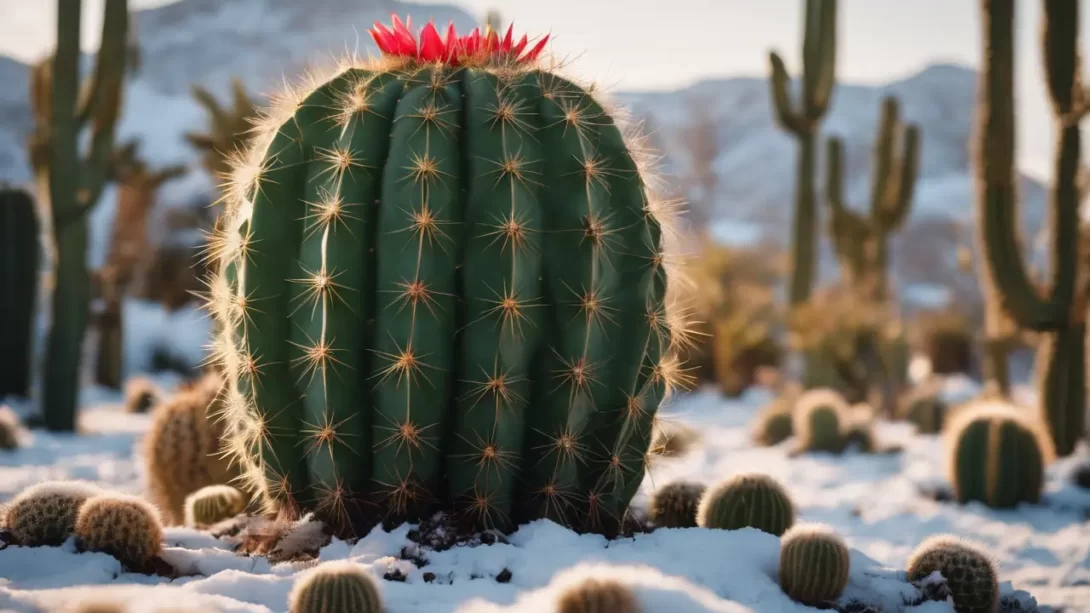Cacti are often associated with scorching deserts and arid conditions. This common image leads many to believe these plants cannot survive in colder climates. However, this is a misconception. In reality, certain cactus species are remarkably resilient to low temperatures. This article explores the fascinating world of cold-hardy cacti, revealing how these adaptable plants can thrive even during winter.
Cactus Hardiness
Plant hardiness is a measure of a plant’s ability to withstand adverse weather conditions, particularly cold temperatures. For cacti, this involves several factors, such as species, acclimatization, and environmental conditions. The USDA Hardiness Zone system plays a crucial role in determining which cacti can survive in specific regions. This system divides North America into zones based on their average minimum winter temperatures, guiding gardeners on the suitability of planting certain cactus species in their local area.
Cold-Hardy Cactus Varieties
Not all cacti are created equal when it comes to surviving chilly temperatures. Some species, like the Opuntia or prickly pear, have adapted to endure freezing conditions. The Sclerocactus, commonly found in high elevations, can also withstand low temperatures. These varieties, among others, showcase a remarkable ability to survive, and even flourish, in cold environments. Each species has its unique threshold for cold tolerance, with some able to withstand temperatures well below freezing.
Preparing Cacti for Winter
Acclimatizing cacti to colder temperatures is crucial for their winter survival. Gradually expose them to lower temperatures to strengthen their tolerance. During winter months, it’s essential to reduce watering significantly. Overwatering can lead to root rot, especially when the plant’s metabolic rate is lower in cold conditions. Ideal winter care also involves ensuring well-draining soil and a location that shields the cactus from harsh elements while still providing sufficient light.
Indoor vs. Outdoor Wintering
Deciding whether to keep cacti indoors or outdoors during winter depends on the species and local climate. Indoor wintering often provides a more controlled environment, reducing the risk of frost damage. For indoor cacti, ensure they receive enough light and are kept in a cool, dry place to mimic their natural dormant state. Conversely, outdoor cacti require strategic placement. Protect them from excessive moisture and consider using frost cloths or moving them to sheltered areas during extreme cold snaps.
Signs of Cold Damage in Cacti
It’s vital to recognize the signs of cold stress in cacti. Symptoms include discoloration, soft spots, or blackened areas, indicating frostbite. If a cactus shows signs of cold damage, immediately move it to a warmer, stable environment. Avoid watering the plant until it fully recovers, as this can exacerbate the damage. For long-term recovery, provide consistent, moderate care and avoid sudden temperature changes. With patience and proper care, many cacti can recover from cold damage.
Frequently Asked Questions
Can cacti left outside in winter survive snow?
Some cold-hardy cacti can survive under snow, as snow can actually insulate against extreme cold. However, prolonged exposure, especially for non-hardy varieties, can be harmful.
How often should I water cacti in winter?
Watering needs drastically decrease in winter. Water only when the soil is completely dry, which may be once a month or less, depending on the environment.
What temperature is too cold for cacti?
This varies by species. Some cacti can survive temperatures as low as 20°F (-6°C), while others may suffer at temperatures below 50°F (10°C).
Conclusion
Cacti are often stereotyped as delicate desert dwellers, but many species exhibit incredible resilience to cold weather. Understanding the hardiness of different cactus varieties, preparing them for winter conditions, and recognizing signs of cold stress are key to helping these unique plants thrive year-round. Gardening enthusiasts should not shy away from experimenting with cold-hardy cacti, as they can add beauty and diversity to winter gardens. The adaptability and endurance of these plants serve as a reminder of nature’s remarkable ability to flourish in various conditions.




